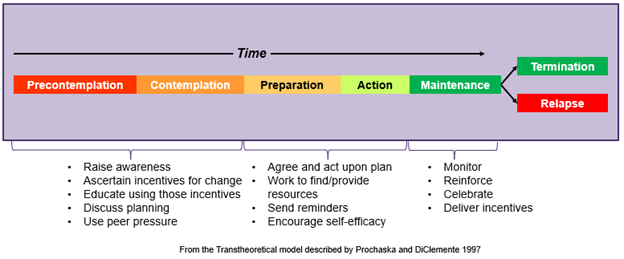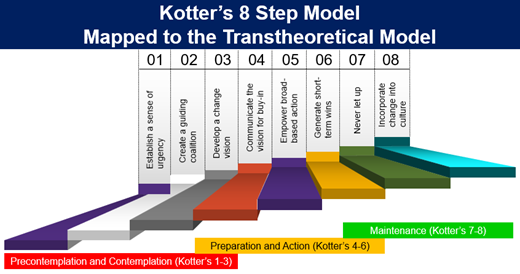 This is the last blog in a series of four aimed at transformation and change management – at the individual and organizational levels. This blog focuses on change management as it relates to transformation.
This is the last blog in a series of four aimed at transformation and change management – at the individual and organizational levels. This blog focuses on change management as it relates to transformation.
I was fortunate to be on a panel co-presenting with Marc Overage, MD/PhD, when he was at the Regenstrief Institute. Here’s my takeaway from his talk comparing installation, implementation, and transformation:
- Installation is hard, and mainly technical.
- Implementation is really hard, and mainly organizational.
- Transition (lasting change) is incredibly hard, and purely human.
- Transformation is a state of profound new personal and enterprise behavior.
Each of these levels associated with technology deployment require adept change management. One my favorite book titles[1] is, “Change is Good…You Go First.” The authors tackled the difficult task of inspiring change. If I was asked to provide a corollary to their title, it would be “Change is Good…Transitions Suck.” So, how do you get someone to the point where they want to change?
Here’s a list of 11 suggestions on how to encourage change followed by some structures that can help you manage the change.:
- Be empathetic and understanding.
- Identify motivating factors. Don’t guess.
- Highlight positive and negative consequences of change. Be transparent.
- Provide information and evidence. Share your rationale. Listen to theirs.
- Enumerate the steps from installation to transformation. Discuss what’s in it for them.
- Offer encouragement and support throughout the steps.
- Provide realistic expectations. Change is a personal journey. People move at very different paces.
- Acknowledge and address concerns and fears without judgment. Develop plans to overcome barriers.
- Lead by example. Embrace the change you’re leading.
- Provide support and resources.
- Acknowledge progress. Celebrate incremental successes.
Change Management – Individual and/or Organization Level
Though a Google search for “change management framework” yields 319 million results, there are two frameworks I would recommend, unless of course your organization already has its own. The first is the Transtheoretical Model which can work with both individuals and corporations. The second is Kotter’s 8 Stage Change Model, primarily focused on corporations. The picture below illustrates in a few words the Transtheoretical Model.

This model is simple, logical, and easy for people of every educational level to understand. For the model above, you’ll need to determine how many individuals are in each stage and how much effort and how many resources should be expended to move them to the right. Moving from precontemplation to contemplation is the hardest move.
When done right, it’s possible to use the transtheoretical model to show patients and families the steps to achieve and sustain change. This model is especially useful for caregivers who are trying get patients and families to assume some personal accountability – the lack of which is the primary reason that people won’t change or relapse. This change model is also useful with friends and family when you’re trying to help someone through change – voluntary or not.
Change Management – Organization Level
The next illustration describes Kotter’s 8 step model and maps the Transtheoretical Model to it. Kotter’s model is very popular and very useful, but not easy to remember. Many sophisticated healthcare organizations embrace Kotter’s model. I’ve added a map below Kotter’s steps to help you understand how they complement each other.

I suggest using the simpler transtheoretical model or the combined model. There’s something for everyone and the corporation in the combined models. If you don’t want to use the Transtheoretical Model to manage change at the corporate level, it can be used to assess the organization’s readiness for change.
Staying in sync is critical. Individuals (staff) and the organization as a whole must move through phases of transformation as close to the same schedule as possible, ideally simultaneously – bottom up (staff) and top down (leadership). If either group fails to move close to simultaneously, change will stagnate and transformation may flounder or fail.
Conclusion
Implementing these actions is challenging, but the outcomes of a digital transformation are well worth the effort. Self-directed evolution allows you and your organization to grow deliberately. Transformation is the responsibility of everyone in management from the Board to the line supervisors. Effective communication, coordination, and collaboration are vital. As an IT leader, it is crucial you understand and represent the perspectives of the individuals impacted. It is important to identify and activate (not just engage) champions at every level in the organization, particularly in the C-suite where resource allocations are determined.
Communicate expectations clearly and unambiguously to all parties and ensure that all efforts and parties are coordinated and synchronized. Be sensitive to the challenges of transition. IT plays an important enabling role in most, if not all, of these actions, so lead while advocating for all parties and channeling the vision of your C-suite peers. The time has come. Hardwire the Quintuple Aim.

This blog is the last in a 4-part series. The first is “From Overhead to Opportunity: Immediate IT Expense Reduction Strategies.” The second is “From Overhead to Opportunity: Eleven IT-Enabled Revenue Enhancement Strategies.” The third is “From Overhead to Opportunity: Digitally Enabled Transformation.”
[1] Mac Anderson and Tom Feltenstein wrote a short book “Change is Good…You Go First: 21 Ways to Inspire Change” in 2015.
